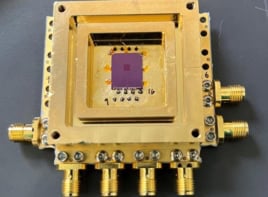Japanese scientists have achieved superconductivity in magnesium diboride at 38 K - almost double the transition temperature of any other metallic superconductor. Jun Akimitsu of Aoyama-Gakuin University in Tokyo and co-workers announced their discovery at the Symposium on Transition Metal Oxides held in Sendai in January. Physicists at Ames Laboratory in the US and at Birmingham and Cambridge Universities in the UK have reproduced the breakthrough - and now the race is on to establish the mechanisms that led to the effect.
The previous highest temperature for a metallic superconductor – niobium tin – was 20 K. Existing superconducting wires and tapes operate at around 16 K and rely on cumbersome liquid helium cooling systems. But a practical device such as a wire or tape made from the new compound – although still some way off – could be cooled using electrical refrigerators. “This is a very exciting discovery”, Colin Gough of Birmingham University told PhysicsWeb.
The Bardeen-Cooper-Schrieffer (BCS) theory of superconductivity explains the behaviour of low-temperature superconductors very successfully, but has proved to be inadequate for high-temperature materials. “The challenge now is to establish whether superconductivity in the new compound is governed by the BCS theory, which is unlikely given its relatively high transition temperature, or if its origins are more obscure”, David Cardwell of Cambridge University told PhysicsWeb. The outcome may shed light on the mechanisms that underlie resistance-free current flow in other high-temperature superconductors.
Magnesium diboride is relatively easy to make – Gough joked that you can even buy it at the chemists – and physicists speculate that it may be possible to raise the superconducting transition temperature by lacing the compound with other elements. “We need to establish the nature of the charge carriers before thinking about which elements to use”, said Cardwell. “But high temperature superconductors – which are oxide in nature – contain predominantly copper, so this might be a reasonable place to start”.
American physicists John Hulm and Bernd Matthias tested many combinations of transition metals in their search for new superconductors in the early 1950s – with much success – but apparently overlooked magnesium diboride.



